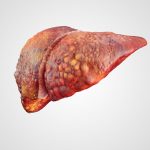 Fatty liver disease risk is higher in postmenopausal women due to increased testosterone levels. During menopause women experience many different changes – many of which pertain to hormones. Although testosterone is typically known as a male hormone, women do have moderate levels of it, but when it increases, especially during menopause, it can have serious consequences.
Fatty liver disease risk is higher in postmenopausal women due to increased testosterone levels. During menopause women experience many different changes – many of which pertain to hormones. Although testosterone is typically known as a male hormone, women do have moderate levels of it, but when it increases, especially during menopause, it can have serious consequences.
Testosterone in women is used for the production of estrogen, sparking the female libido and helping maintain bone and muscle mass. By the time menopause occurs testosterone levels in women are cut in half – the prime is around 20 years of age. Even when estrogen is no longer produced by the ovaries they still continue to make testosterone, which can continue to increase its levels. Furthermore, the adrenal glands also continue to make testosterone during menopause, contributing to its higher levels.
Advertisement
High testosterone increases the risk of fatty liver in postmenopausal women
 Researchers found that high levels of bioavailable testosterone in postmenopausal women increases their risk of nonalcoholic fatty liver disease (NAFLD). The researchers wrote, “To our knowledge, this is the largest study to date showing the association of circulating multiple sex hormone levels with liver fat, as measured using [computed tomography] scan, in a population-based multi-ethnic sample of both men and women.”
Researchers found that high levels of bioavailable testosterone in postmenopausal women increases their risk of nonalcoholic fatty liver disease (NAFLD). The researchers wrote, “To our knowledge, this is the largest study to date showing the association of circulating multiple sex hormone levels with liver fat, as measured using [computed tomography] scan, in a population-based multi-ethnic sample of both men and women.”
Data was collected from 2,835 postmenopausal women and 2,899 men. Each participant was tested for bioavailability of testosterone along with estradiol (E2), dehydroepiandrosterone and sex hormone binding globulin (SHBG) with liver fat.
The researchers added, “Reports of studies in small samples suggest that lower levels of SHBG are associated with increased [nonalcoholic fatty liver disease] in men and menopausal women. Another study reported an association between low levels of dehydroepiandrosterone and NAFLD. However, no associations with estradiol or testosterone have been reported in U.S., multiracial, population-based studies.”
Women with the most bioavailable testosterone were more likely to have a fatty liver compared to women with low testosterone levels. Similarly, men with high testosterone also had fatty livers compared to men with lower readings. But the men with high SHBG were less likely to have fatty livers compared to those with low SHBG.
The researchers concluded, “We have shown that there is a strong association of fatty liver with high E2 levels in men and women and low SHBG levels in men independent of demographic, anthropometric and cardiometabolic risk factors. Higher androgenic milieu is associated with fatty liver in women only. Future studies with measurement of liver inflammation and fibrosis are necessary to determine whether these associations may give rise to clinically significant liver-related morbidity.”
Fatty liver disease risks due to diet
 Diet plays a large role in preventing, and even causing, fatty liver disease. In fact, NAFLD is on the rise in America due to the average American diet, which is high in fat, calories and sodium. If untreated nonalcoholic fatty liver disease can progress to fibrosis – scarring of the liver – or cirrhosis.
Diet plays a large role in preventing, and even causing, fatty liver disease. In fact, NAFLD is on the rise in America due to the average American diet, which is high in fat, calories and sodium. If untreated nonalcoholic fatty liver disease can progress to fibrosis – scarring of the liver – or cirrhosis.
If you wish to prevent nonalcoholic fatty liver disease, it’s important to examine your food habits. Are you primarily visiting fast food restaurants or are you preparing meals at home? Are you eating the recommended amount of fruits and vegetables, or are potatoes your go-to veg? In order to protect your liver you need to transform your diet from high-fat to wholesome.
Aside from avoiding high-fat foods, it’s also important that you avoid high-glycemic foods like potatoes, white bread, white rice, chocolate bars and essentially anything with added sugar, processed grains, and alcohol.
Obesity and fatty liver disease
Aside from diet, being overweight or obese can also contribute to NAFLD. Nonalcoholic fatty liver disease occurs when fat accumulates in and around the liver without the help of alcohol – that is known as alcoholic fatty liver disease.
Obesity and nonalcoholic fatty liver are closely associated. Excess fat leads to insulin resistance which, when paired with hypertension and high cholesterol, spells disaster for the liver.
Although the exact relationship between obesity and nonalcoholic fatty liver disease is not fully known, researchers do know that by losing weight a person can work towards a healthier liver. In fact, research shows that by losing 10 percent of your current body weight, liver enzymes begin to improve.
Lifestyle changes to reduce fatty liver disease
Simply lifestyle changes can be used to prevent and reduce your risk of fatty liver disease.
 Lose weight if you are overweight or obese.
Lose weight if you are overweight or obese.- Minimize alcohol consumption.
- Don’t smoke.
- Reduce sodium and sugar intake.
- Reduce carbohydrates.
- Eat more fruits, vegetables and lean protein.
- Exercise regularly.
- Drink more water.
- Cut out sodas and sugary beverages.
- Avoid junk food, candy, and chocolate.
- Avoid processed or fried foods.
By following these tips you can better help your liver stay as healthy as possible.
Related Reading:
The one thing for a healthy liver
Liver-mortality has moved its way to being one of the top 12 causes of death within the United States. Nonalcoholic fatty liver disease (NAFLD) has risen to be the most common form of liver disease in the Western world. Previously NAFLD was deemed a benign condition, but as research continues to grow it has been found that NAFLD can actually be quite dangerous. Continue reading…
Advertisement
Diabetics unaware of potential nonalcoholic fatty liver disease
Nonalcoholic fatty liver disease (NAFLD) is commonly found in those with type-2 diabetes and remains to be the most common form of liver disease. NAFLD results from a build-up of fat in the liver which can lead to fibrosis – scarring of the liver – and ultimately cirrhosis or liver failure. Continue reading…
Sources:
http://www.hopkinsmedicine.org/digestive_weight_loss_center/conditions/fatty_liver_disease
http://halifaxcitizen.ca/2015/06/01/diet-lifestyle-tips-for-fatty-liver
http://fattylivercured.com/foods-to-avoid-with-fatty-liver/
http://www.menopause.org/for-women/sexual-health-menopause-online/changes-at-midlife/changes-in-hormone-levels
